Is Stage 4 Cancer Always Terminal? Real Facts Patients Need
 Jul, 12 2025
Jul, 12 2025
Cancer. Just the word makes your heart skip a beat, right? When you hear “stage 4,” it’s like the ground drops out. You might picture white hospital walls, hushed conversations, and maybe the worst-case scenario. It’s scary, and there’s a ton of confusion out there. Everyone has an opinion—from what they overheard at the pharmacy, to something their coworker’s cousin shared on social media. Most people think stage 4 cancer means you’ve reached the end of the road. But is that really the case? Let’s break down what “stage 4” actually means and why a lot of what we “know” might be wrong.
What Stage 4 Cancer Really Means
First things first: “stage 4” is a medical classification for cancer. Doctors use it to describe cancers that have "metastasized"—meaning the disease has spread from its original spot to other parts of the body. It's the highest stage in most cancer types. But here's where everyone gets tripped up: stage 4 is not a synonym for "terminal." The word "terminal" is used when doctors believe there are no effective treatments left and life expectancy is limited, sometimes within six months or less. With so many breakthroughs in modern medicine—targeted therapies, immunotherapy, high-tech radiation—many people living with stage 4 cancer end up surviving much longer than anyone predicted even ten years ago.
The confusion isn’t just in your head. According to the National Cancer Institute, about 20% of people diagnosed with stage 4 breast cancer are still living five years later. For prostate cancer, five-year survival for stage 4 is around 31%, and for certain types of leukemia and lymphoma, the odds are much higher. There are even rare cases where people reach complete remission. So, stage 4 means advanced cancer that has spread, but not all stage 4s are identical. Ask five different patients, and you’ll get five very different stories. Cancer type, age, general health, genetics, and new treatments shape each person’s journey.
If you want to look at specific numbers, check this:
| Cancer Type | 5-Year Survival Rate (Stage 4) |
|---|---|
| Breast | 29% |
| Prostate | 31% |
| Colon | 12% |
| Lung (Non-small cell) | 8% |
| Melanoma (Skin) | 32% |
Those numbers clearly show it’s not always the same story. So if you or a loved one is dealing with a stage 4 cancer diagnosis, don’t think the sand has already run out of the hourglass. Treatments keep improving, and each case truly is unique.
Why Stage 4 Sounds So Scary—and Busting the Myths
The phrase “stage 4 cancer” still causes people to freeze for a reason. Nobody wants to talk about death and loss of control. But the truth is, the term "terminal" gets thrown around way too easily. Not all doctors use the words in the same way, which can make things extra confusing. You might hear someone say, "it's late-stage, so it's terminal," but those two terms aren't interchangeable in medical speak. Plenty of people are living well with stage 4 cancer for years, working, socializing, and checking off bucket list items.
There’s another big myth that people often hear: “Stage 4 means there’s nothing you can do except wait.” That’s simply not true today. Many types can respond to aggressive chemotherapy, immunotherapy, hormone treatments, oral medications, and surgery—even at stage 4. New cancer drugs get FDA approval every year. Immunotherapy, for example, has practically rewritten the playbook for treating stage 4 melanoma. The U.S. saw survival rates for advanced melanoma jump from less than 20% to roughly 50% for some patients, thanks to treatments like Keytruda and Opdivo. Even more, many oncologists treat late-stage cancer as a chronic condition—something you might need to manage, not necessarily something that ends life soon.
Why do these myths keep going? Part of it comes from old information. Back in the '80s and '90s, stage 4 was almost always a death sentence. Now, knowledge moves faster than dinner gossip but not as fast as treatment innovations. There’s also a lack of open conversation. Patients sometimes don’t ask every question or doctors slip into “medicalese.” So yes, it’s daunting, but there’s real hope—and that hope is grounded in science, not just optimism.
Want a real-world perspective? Dr. Siddhartha Mukherjee, the author of "The Emperor of All Maladies," once put it this way:
“Cancer is not simply a disease but a process that unfolds in unpredictable ways. What seemed impossible yesterday keeps getting challenged by new research, treatment, and the resilience of people living with cancer.”

Living With Stage 4: Choices, Challenges, and Success Stories
Now let’s get practical. What does day-to-day life look like after a stage 4 diagnosis? The answer depends hugely on individual health, cancer type, available treatments, and support systems. Some people will need regular treatments or maintenance drugs to keep the disease under control. Others might go through periods where their cancer is “stable” (not growing or shrinking), and some will even get a no-evidence-of-disease report after years in treatment.
Modern medicine is all about personalization. Oncologists look at genetic markers and use blood or tumor profiling to match people with the most promising therapy. A 2022 European study found that 37% of stage 4 lung cancer patients benefited from targeted therapy aimed at the cancer’s unique genetic mutations. Others qualify for clinical trials, giving early access to next-gen drugs. That’s why having a team with experience in your specific cancer is more important than ever.
But it’s not just about pills and infusions. Living well with stage 4 cancer means learning how to manage side effects like fatigue, nausea, anxiety, and pain. Support groups make a difference. Good nutrition and exercise—even walking or stretching—can improve mood and stamina. Think about complementary therapies too: meditation, music, massage, and even humor therapy. And keep this in mind, the National Comprehensive Cancer Network recommends all late-stage cancer patients talk regularly with social workers or counselors, not just doctors, to help keep spirits strong.
Here’s something most people don’t expect: a lot of people with stage 4 cancer go back to many of their daily routines, from work to hobbies. There are financial and emotional challenges, sure, but new apps and online tools let patients track symptoms, chat with their care team, and even book telemedicine visits from bed. People are writing blogs, hosting podcasts, or just hanging out with friends—living out loud, not quietly waiting.
If you want some names and faces: Tanya Prather (diagnosed with stage 4 colon cancer in her 40s) traveled the country in a van while on chemotherapy, sharing everything on Instagram. Craig Sager, the famous basketball sideline reporter, kept working for years with stage 4 leukemia, bright suits and all. Listen to what Ginny Mason from the Inflammatory Breast Cancer Research Foundation said after 18 years of her diagnosis:
“Doctors told me at first to get my affairs in order, but years later, here I am: still living, still laughing, still raising hell.”
Talking to Doctors, Making Plans, and Finding Hope
If you, a friend, or family member have been told, “It’s stage 4,” the first thing to do is take a breath. Yes, it’s a big shock. But don’t let panic—or outdated information—shut down your questions. Ask your doctor these essential questions (in plain language):
- What do you mean by “stage 4” in my case? How far has the cancer spread?
- Are there still treatments that can slow the disease or help me live longer?
- Is the goal to cure my cancer, keep it stable, or manage symptoms?
- Can I get a second opinion, or should I see a specialist?
- Are there new trials or therapies I might qualify for?
- What lifestyle changes can help support my treatment?
- Who can help me deal with the worry, sadness, or stress?
Bring someone to appointments—two sets of ears hear better than one, and you’ll remember more. Write things down. Don’t be afraid to push for simple explanations or more time. Sometimes, science moves faster than bedside manners.
One more thing: plan for hope, not just the worst. People find strength in unlikely places—neighbors, online cancer forums, even new friendships made in waiting rooms. Look into financial resources for cancer patients if treatment costs are daunting (the American Cancer Society and CancerCare both help with this). Some employers are more flexible now about sick leave and “remote work” for medical reasons than ever before. Don’t assume the future will be as hard as the day you first hear the news.
Here’s the bottom line, straight from Dr. Deborah Schrag, chair of the Department of Medicine at Memorial Sloan Kettering Cancer Center:
“A stage 4 cancer diagnosis isn’t an immediate death sentence. We’re seeing more people live longer, stronger lives with advanced cancers thanks to modern treatment.”
No one wants this diagnosis. But don’t let outdated ideas steal your hope. Stage 4 means the cancer has spread, but thanks to real people and real science, it doesn’t always mean “terminal.” Ask questions, seek out strong doctors, fight for support, and live with purpose. There’s more road ahead than most people realize.